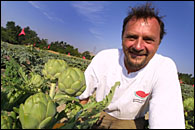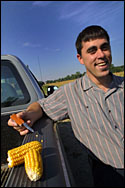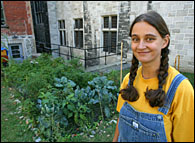Ripe for the picking
 Horticultural Technician Mike Bleho
Horticultural Technician Mike BlehoPHOTO: Owen Egan |
|
We all had our complaints about this past summer. Too wet and too cold for too long back in June. Too hot and dry once July took hold. But with the refreshing autumn air now back in circulation, many of us at McGill will soon forget the vicissitudes of summer in the age of global warming.
Not so those who till the earth. They cash in now the slow hand dealt by sister summer. Just ask any McGill farmers -- and there are more than you'd guess. Mike Bleho, for instance, horticulture technician who supervises the three-acre plantation of vegetables at the Macdonald Campus. He's by turns radiant and downright longfaced walking through the rows of tomatoes, eggplants, melons, artichokes and fields of pumpkins.
It's the last category that suffered most from the cold, wet spring. "They're pathetic," he says, nodding in the direction of the pumpkin field and wondering aloud if there will be enough of the hallowed fruit this year for Hallowe'en. "There won't be any 35-pounders this year," adds Jean-Pierre Laplaine, senior horticultural technician.
Soon the horticultural workers will be piling the orange globes littered throughout the field so they can be easily covered with a tarp in the event of frost. "If frost gets to the pumpkin, it makes the skin go soft and it's no good for anything," says Laplaine. In a week or two, they'll be carted to the Macdonald Campus Market to be sold.
Not many other Macdonald horticultural crops are kept in waiting once they're ripe. The abundance and variety of the peppers, melons and tomatoes in the field and at the market are impressive. These are the sunbabies. Give 'em enough water and they'll turn every ray of sun into flesh.
Bleho leads the way to the melon patch. Unlike their tougher cousins in the cucurbit family (squash and pumpkins are planted as seedlings straight into the field with no irrigation), the melons get the royal treatment; they're planted in the earth through long rows of black plastic that keep in moisture, hold the heat and keep out the weeds. Furthermore, the melons are privy to a constant drip of fertilized water, known as "fertigation," through pipes running the length of the plastic.
A little farther east in the newer apple orchards, Laplaine, who's responsible for the four acres of apple orchards, isn't looking too happy. "Some of the apples will have to be picked now before they fall," he says. Brushing by a young Novamac tree, one of several cultivars the horticultural service is trying for the Quebec Ministry of Agriculture, Laplaine explains that the overly hot and dry summer and fall means the apples will be ready earlier than usual.
 Macdonald Campus Farm Manager Phil Lavoie
Macdonald Campus Farm Manager Phil LavoiePHOTO: Owen Egan |
|
Not far from the horticultural fields, you can hear the harvester making its rounds of the north west cornfield, just south of highway 40. This is the bum crop of the two fields of corn planted last spring. After planting, the rains flooded the field, making it impossible for the machinery to come in to spray the weeds. You can't run heavy machinery on wet soil because it compacts the earth, explains Phil Lavoie, manager of the Macdonald Campus Farm, who's responsible for the corn and hay crops grown for the farm's 70 cows.
Once the harvester comes in, Lavoie runs his fingers through the leafy mass the machine has chopped up. There aren't many corn kernels. "What you want is a good ratio of grain to leaf," he says.
The lack of rain also meant that each husk of corn didn't grow to its potential. Pointing to an ear of mango-orange coloured corn in his hand, Lavoie says, "It should be three to four inches longer. That's the lack of water not filling the kernels." While the corn might not be the best ever, Lavoie's not worried. There will be enough to fill the six silos and keep the cows in corn and corn silage (a fermented mix of chopped corn and corn plant) for most of the year.
Closer to Lake St. Louis and just south of the EcoResidence is a garden where the drought had little effect. A dazzling tangle of beans grown tall on their supports, sunflowers threatening to tumble under their own weight, and tomatoes showing in many shapes and colours, the Macdonald Com-munity Garden withstood the drought due to the labour-intensive nature of organic gardening and the availablility of water from the campus houses nearby.
Frédéric Thériault began plotting and planting -- seeding in the greenhouse, at least -- last April. Thériault's dream was to revitalize the 30 m by 30 m plot, that had been used mostly by international students but not to capacity, and to give members of the Macdonald community the opportunity to experiment with different techniques of organic agriculture.
He points to the Swiss chard and strawberry plants. "You see this sheet mulching? It worked very well for these plants." Sheet mulching is the practice of laying down a biodegradable material, such as cardboard or newspaper, on top of the area to be planted, then planting the seedlings through it and covering the material with a layer of compost.
"It cuts down the weeds, especially the quack grass," says Thériault. "With time the paper breaks down and the water helps the nutrients in the compost filter down through the soil."
Another technique Thériault and his fellow 24 gardeners tried was permaculture, the practice of maximizing the number of perennial fruit-bearing plants and trees. Some of the plants, like the raspberry canes and the potato-like Jerusalem artichoke, did well and Thériault's optimistic the tiny hartnut tree he planted will survive the winter.
While the fruits of the Mac community garden are for the gardeners and their friends, at a similar, though smaller, garden downtown, members of the McGill community can help themselves -- at least to the kale.
 McGill School of Environment student Vicky Baker
McGill School of Environment student Vicky BakerPHOTO: Owen Egan |
|
"No one's taking any and I've taken enough," says Vicky Baker, pointing to the ripple-edged blue-mauve leaf at the end of the plot behind the McGill School of Environment. Baker, an MSE student, began the garden last summer after "seeing all that lawn" and knowing the extent of the waiting lists for municipal community gardens.
This year, she and the team of five gardeners doubled its size and cultivated half the garden in conventional rows and the other half in a let the seeds fall where they may fashion. A tenet of permaculture is to disturb the soil as little as possible and to see which of the scattered seeds will outcompete the others.
"Earlier in the season, the squash and spinach dominated; now it's the rogue tomatoes," she says, explaining that the tomatoes have grown out of tomato seeds in the compost dug into the soil last spring. In fact, much of what was planted in "chaos corner," as she calls the latter, were gifts of the compost, all of which hails from Lola Rosa, the popular vegetarian restaurant on Milton Avenue. Which explains the surprising number of avocado plants in the midst of the tomatoes.
Baker doesn't think the garden will try the chaos method next year. "You can't find anything!" She will, however, keep the squirrel control technique of chicken wire around the garden, sunflowers outside the fence, for the squirrels to eat, and marigolds inside the garden, whose odour repels the rapacious rodents.
What's surprising about the MSE and Mac Community Garden is that neither knew that the other existed, even though both teams of gardeners are trying similar things. Both, for instance, are planning now for next year, throwing harvest parties and holding workshops on collecting seeds. Perhaps one of the surprises of this year's harvest at McGill will be some cross-campus pollination.

